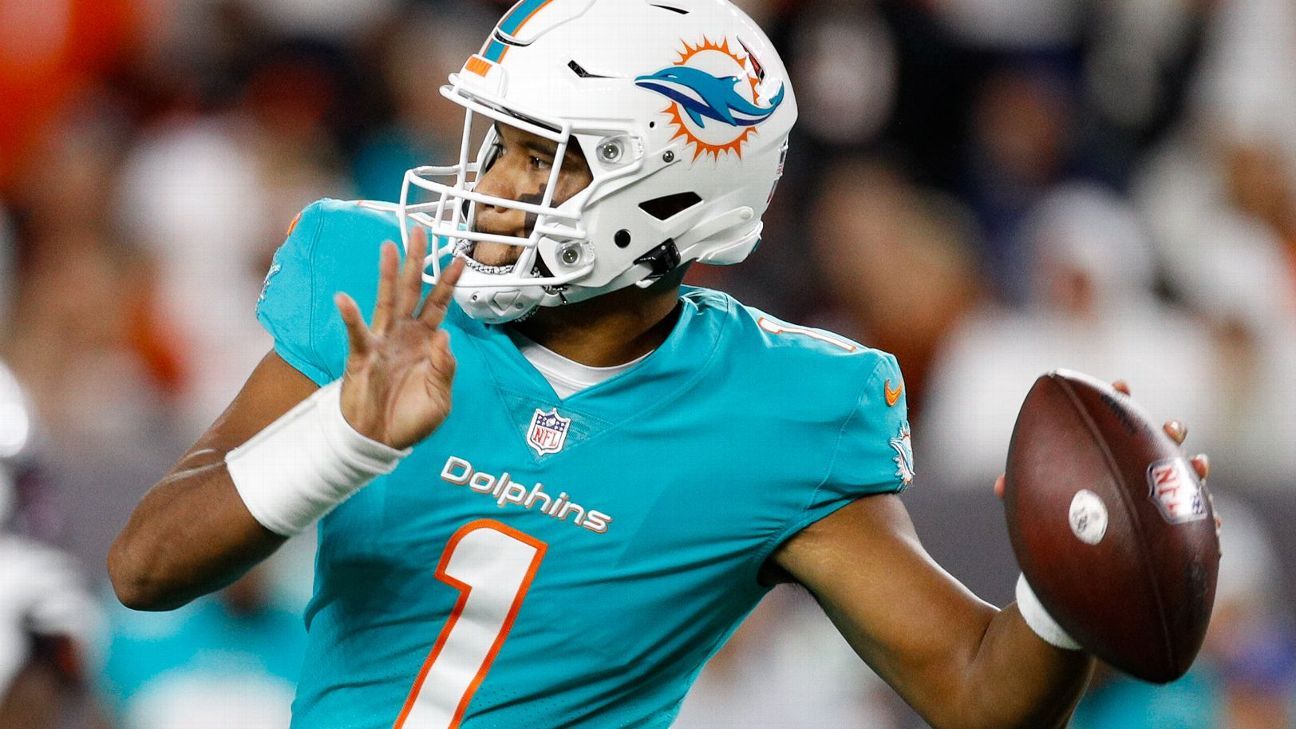The NFL and NFL Players Association released a joint statement Saturday finalizing their review of the application of the league’s concussion protocol following Miami Dolphins quarterback Tua Tagovailoa‘s apparent head injury on Sept. 25, implementing an amendment to said protocol.
The statement concluded that although the step-by-step process of the concussion protocol was followed, “the outcome in this case was not what was intended when the Protocol was drafted.”
Tagovailoa appeared to sustain a head injury during the Dolphins’ game against the Buffalo Bills on Sept. 25 when he hit his head on the ground, and then stumbled while attempting to return to the huddle. The stumble was considered a display of gross motor instability, which is one of the protocol’s “no-go” symptoms that requires a player be removed from a game without the possibility to return.
He was immediately taken to the locker room for a concussion evaluation but informed both the team’s physician and the unaffiliated neurotrauma consultant (UNC) jointly hired by the NFL and NFLPA that a back and ankle injury caused him to stumble; the report found that Tagovailoa had previously reported both injuries prior to hitting his head on the ground.
Once it was determined that his observed instability was not neurologically caused, Tagovailoa passed his evaluation and was allowed to return to the game. However, neither the team physician nor the UNC examined his back during the evaluation, “but instead relied on the earlier examination conducted by other members of the medical staff.”
After the game, the NFLPA initiated a joint review of whether the process as a whole was properly applied. It exercised its right to terminate the UNC who performed Tagovailoa’s initial evaluation after the union found he made “several mistakes” during the process, beyond following the step-by-step process of the protocol, multiple sources told ESPN.
The investigation included an NFLPA-led interview of Tagovailoa, as well as joint interviews with members of the Dolphins’ medical staff, the head athletic trainer, the booth ATC spotter, the UNC and Tagovailoa, and a review of relevant reports and video pertaining to the incident.
“Rather than being simply a ‘check the box’ process, the Protocol was designed to ensure that highly credentialed and experienced physicians — approved and paid for by the NFL and NFLPA — are available on game day and to create a standardized approach to concussion evaluation where competitive decisions never usurp quality care,” the joint statement read. “If a concern arises over compliance with the Protocol, either the NFLPA or the NFL can request an investigation into the actions of the medical staff which will be conducted jointly.”
Both parties agreed to amend the protocol by adding ataxia to the list of “no-go” symptoms.
“‘Ataxia’ is defined as abnormality of balance/stability, motor coordination or dysfunctional speech caused by a neurological issue,” the statement read. “In other words, if a player is diagnosed with ‘ataxia’ by any club or neutral physician involved in the application of the Concussion Protocol, he will be prohibited from returning to the game, and will receive the follow-up care required by the Protocol.”
In a Zoom call with reporters Saturday evening, Dr. Allen Sills, the NFL’s chief medical officer, said that under this amended protocol, Tagovailoa would have been diagnosed with a concussion based on a display of ataxia during the game against the Bills, and prohibited from returning.
Neither Sills nor NFL Executive Vice President Jeff Miller supported the NFLPA’s decision to fire the UNC involved, with Sills calling it “extremely unfortunate” to make such an action prior to the completion of the investigation.
“It’s not something we would have done and didn’t,” Miller said. “We never supported terminating him.”
Tagovailoa also cleared follow-up concussion evaluations in the days following his initial examination and did not show concussion symptoms at any point. He was cleared to play four days after his initial evaluation against the Cincinnati Bengals on Sept. 29 but sustained a concussion after hitting his head on the ground once again, and was briefly hospitalized before being discharged and allowed to fly back to Miami with the team.
Dolphins coach Mike McDaniel said “with 100% conviction” that he felt confident in how Tagovailoa was handled following the Sept. 25 incident and insisted that Tagovailoa was cleared by an independent neurologist and that he personally interacted with him throughout the week and saw no signs of a head injury.
“I’m in steady communication with this guy day in and day out,” McDaniel said. “We’re talking about high-level football conversations about progressions and defenses and recalling stuff from two weeks previous and then him having to reiterate a 15-word playcall. All things, absolutely no signs. There was no medical indication, from all resources, that there was anything regarding the head.
“Beyond an eyeball test, which I know for a fact you guys would not be very comfortable if I was just relying on that — I mean, it’s the reason why we have tests,” McDaniel added. “He did not have a head injury. So guys hit their heads all the time, and that’s why I was adamant [that] he was evaluated for having a head injury, and he did not have one. And when I tell you he was in complete mental concert, talking to us through it, and then he played the whole game and then he did a press conference and then he did media all week.”
Tagovailoa is currently in concussion protocol and will not play Sunday against the New York Jets. Teddy Bridgewater will start for Miami.
